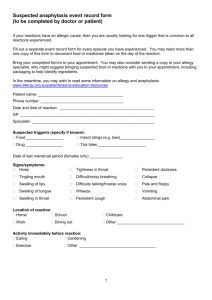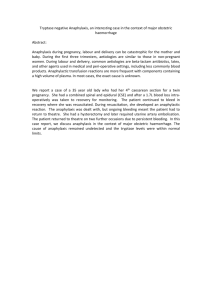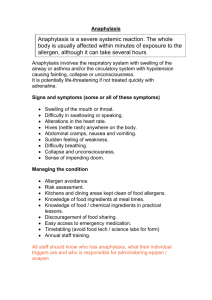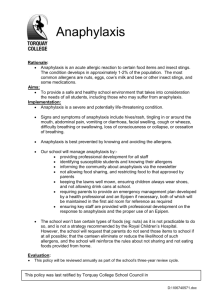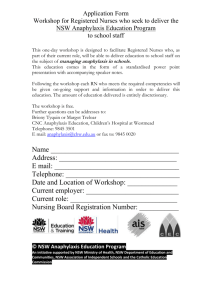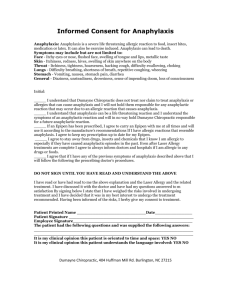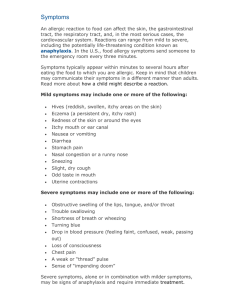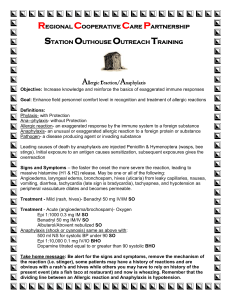22300VIC Course in First Aid Management of Anaphylaxis
advertisement
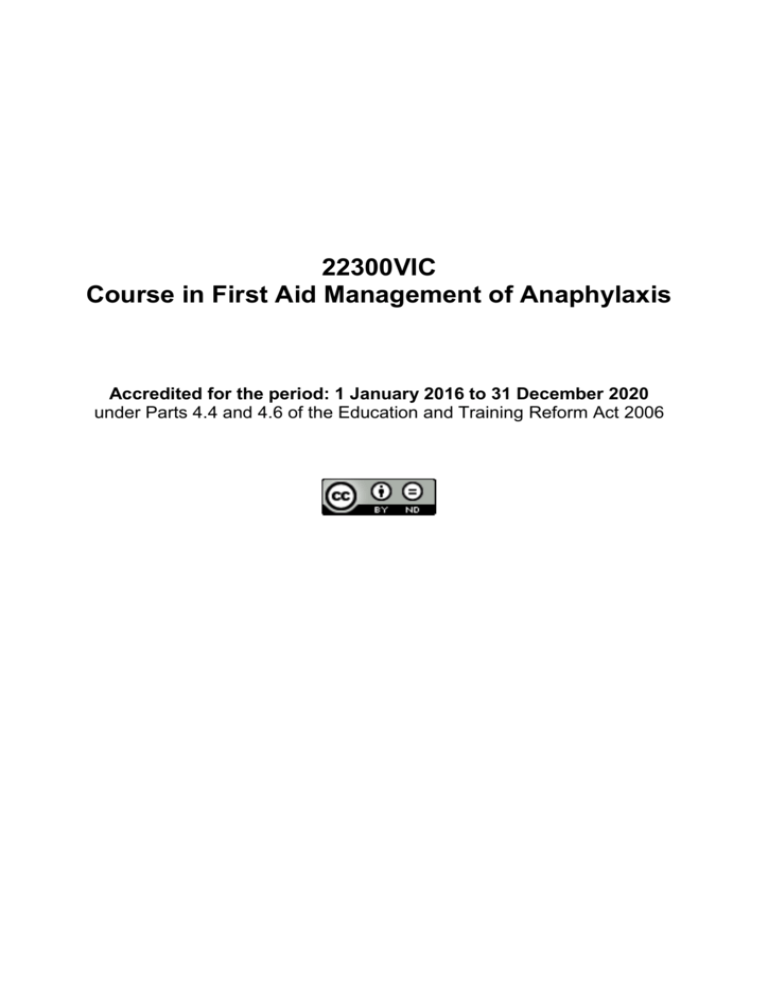
22300VIC Course in First Aid Management of Anaphylaxis Accredited for the period: 1 January 2016 to 31 December 2020 under Parts 4.4 and 4.6 of the Education and Training Reform Act 2006 Document Status: This document is an exact copy of the document, which is listed on the State Register of Accredited Courses and Recognised Qualifications and the www.training.gov.au site. Accredited from 1st January 2016 to 31st December 2020 © State of Victoria (Department of Education and Training) 2015. Copyright of this material is reserved to the Crown in the right of the State of Victoria. This work is licensed under a Creative Commons Attribution-NoDerivs 3.0 Australia licence (http://creativecommons.org/licenses/by-nd/3.0/au/). You are free to use, copy and distribute to anyone in its original form as long as you attribute Higher Education and Skills Group, Department of Education and Training as the author, and you license any derivative work you make available under the same licence. Disclaimer In compiling the information contained in and accessed through this resource, the Department of Education and Training (DET) has used its best endeavours to ensure that the information is correct and current at the time of publication but takes no responsibility for any error, omission or defect therein. To the extent permitted by law DET, its employees, agents and consultants exclude all liability for any loss or damage (including indirect, special or consequential loss or damage) arising from the use of, or reliance on the information contained herein, whether caused or not by any negligent act or omission. If any law prohibits the exclusion of such liability, DET limits its liability to the extent permitted by law, for the resupply of the information. Third party sites This resource may contain links to third party websites and resources. DET is not responsible for the condition or content of these sites or resources as they are not under its control. Third party material linked from this resource is subject to the copyright conditions of the third party. Users will need to consult the copyright notice of the third party sites for conditions of usage. Table of Contents Section A: Copyright and course classification information 1. Copyright owner of the course 1 2. Address 1 3. Type of submission 1 4. Copyright acknowledgement 1 5. Licensing and franchise 1 6. Course accrediting body 1 7. AVETMISS information 1 8. Period of accreditation 1 Section B: Course Information 1. Nomenclature 1.1 Name of qualification 1.2 Nominal duration of the course 2 2 2 2. Vocational or educational outcomes 2 3. Development of the course 3.1 Industry/enterprise/community needs 3.2 Review for re-accreditation 2 2 4 4. Course outcomes 4.1 Qualification level 4.2 Employability Skills 4.3 Recognition given to the course 4.4 Licensing/regulatory requirements 5 5 5 5 5 5. Course rules 5.1 Course structure 5.2 Entry requirements 6 6 6 6. Assessment 6.1 Assessment strategy 6.2 Assessor competencies 6 6 8 7. Delivery 7.1 Delivery modes 7.2 Resources 8 8 9 8. Pathways and articulation 10 9 Ongoing monitoring and evaluation 10 Section C: Units of competency 11 VU21800 Provide first aid management of anaphylaxis 12 VU21801 Develop risk minimisation and risk management strategies for anaphylaxis 18 Section A: Copyright and course classification information 1. Copyright owner of the course Copyright of this document is held by the Department of Education and Training, Victoria. © State of Victoria (Department of Education and Training) 2015 Day to day contact: Human Services Curriculum Maintenance Manager Swinburne University of Technology PO Box 218 Hawthorn VIC 3122 Email: cmmhs@swin.edu.au Telephone: 03 9214 5034 / 9214 8501 2. Address Executive Director Training System Performance and Industry Engagement Higher Education and Skills Group Department of Education and Training (DET) GPO Box 4367 Melbourne VIC 3001 3. Type of submission Re-accreditation. 4. Copyright acknowledgement Copyright of this material is reserved to the Crown in the right of the State of Victoria. © State of Victoria (Department of Education and Training) 2015 5. Licensing and franchise This work is licensed under a Creative Commons Attribution-NoDerivs 3.0 Australia licence (http://creativecommons.org/licenses/bynd/3.0/au/). You are free to use, copy and distribute to anyone in its original form as long as you attribute Higher Education and Skills Group, Department of Education and Training as the author and you license any derivative work you make available under the same licence. 6. Course accrediting body 7. AVETMISS information 8. Period of accreditation Victorian Registration and Qualifications Authority ANZSCO Code (Australian and New Zealand Standard Classification of Occupations) GEN20 Non-industry specific training ASCED Code – 4 digit (Field of Education) 0699 National course code 22300VIC Other Health 1 January 2016 – 31 December 2020 22300VIC Course in First Aid Management of Anaphylaxis Version 1 © State of Victoria 2015 Page 1 of 25 Section B: Course information Section B: Course information 1. Nomenclature Standard 1 AQTF Standards for Accredited Courses 1.1. Name of the qualification Course in First Aid Management of Anaphylaxis 1.2. Nominal duration of the course 4 hours 2. Vocational or educational outcomes 2.1. Purpose of the course Graduates of the 22300VIC Course in First Aid Management of Anaphylaxis will be able to: 3. Development of the course 3.1. Industry / enterprise/ community needs Standard 1 AQTF Standards for Accredited Courses Identify the triggers, signs and symptoms of allergic reactions, including anaphylaxis. Develop risk management and risk minimisation strategies for anaphylaxis. This includes the development and implementation of pre-emergency risk assessment/management and the development of individual anaphylaxis management plans. Provide an emergency first aid response to an individual experiencing anaphylaxis, until the arrival of medical assistance. This includes standard first aid procedures and the specific skills and knowledge to administer adrenaline using an adrenaline autoinjector. Standards 1 and 2 AQTF Standards for Accredited Courses This course was initially developed and accredited in 2005 in response to an identified need by key Victorian first aid providers, such as St John Ambulance and Australian Red Cross. There is a need for first aiders to treat with the administration of adrenaline to casualties who have access to an adrenaline autoinjector as part of their individual Australasian Society of Clinical Immunology and Allergy (ASCIA) Action Plan for Anaphylaxis, in the event of a casualty having a severe allergic reaction. The training is in response to the increasing number of individuals in the population with the potential to experience anaphylaxis. This course provides nationally recognised training for workers, or nominated workplace first aiders, from any industry sector and addresses the provision of care to adults and/or children in the workplace who are diagnosed as being at risk of anaphylaxis, or 22300VIC Course in First Aid Management of Anaphylaxis Version 1 © State of Victoria 2015 Page 2 of 25 Section B: Course information displaying signs/symptoms of anaphylaxis. In Australia, there is an increasing number of children and adults being diagnosed with life threatening allergies. In children, food allergy is the most common cause of anaphylaxis triggering over 80% of paediatric anaphylaxis presentations. For older adults, medications are the most common cause, contributing to 57% per cent of all deaths due to anaphylaxis.1 Since its initial accreditation in 2005, this course has experienced a high demand. In part, the demand has stemmed from the increased awareness of comprehensive strategies for the management and emergency response to anaphylaxis episodes and also from changes in legislation. The existing course (22099VIC) meets the needs of each of the following legislation and it is anticipated that the reaccredited course will meet these requirements: Ministerial Order 706 - Anaphylaxis Management in Victorian Schools Children’s Services Regulations 2009 Education and Care Services National Regulations 2011 This course, although aimed at children’s services and schools, is used across other industries, such as Aged Care facilities, workplaces etc. Nationally, 165 RTOs have the course on their scope of registration and 125 of these are registered to deliver in Victoria. Although the figures on enrolment are not comprehensive due to the non-mandated reporting of fee-for-service activity to DET, 19 of the RTOs who access VTG funding reported the following trend in enrolments: 2012 1,850 2013 1,800 2014 816 Whilst there is a downward trend in enrolments indicated, there is still a strong demand for the course. There are no Training Package qualifications or units of competency that: a) address the first aid response for anaphylaxis as a standalone competency b) are applicable to all industry settings, and c) include associated pre-emergency risk minimisation and management strategies. A Project Steering Committee was formed to oversee the re-accreditation process and the members were: Carol Whitehead Royal Children’s Hospital Melbourne “Anaphylaxis: key messages for health professionals”, Victorian Department of Health, http://www.health.vic.gov.au/chiefhealthofficer/publications/anaphylaxis_health_professionals.htm 1 22300VIC Course in First Aid Management of Anaphylaxis Version 1 © State of Victoria 2015 Page 3 of 25 Section B: Course information Prof. Mimi Tang Barbra May Andrew Fleming Stephen McFadyen Janelle Savery Phillipa Wilson Sally Voukelatos Dr Wendy Norton Sally McMillan Sandra Vale Kate Allwood Steve Passalis Royal Children’s Hospital Melbourne Australian Red Cross Community Services and Health Industry Training Board (CS&H ITB) The Gordon TAFE St John Ambulance (Victoria) Premium Health Allergy & Anaphylaxis Australia Allergy & Anaphylaxis Australia Royal District Nursing Service (RDNS) Education & Learning Centre Australasian Society of Clinical Immunology and Allergy (ASCIA) Quality Assessment and Regulation Division, Department of Education and Training (DET) Wellbeing, Health & Engagement Division, Department of Education and Training (DET) In attendance: Autumn Shea Jennifer Fleischer Sam McCurdy CMM Human Services, Swinburne University CMM Human Services, Swinburne University Dewhurst Consultancy Pty Ltd The Steering Committee members reviewed the skills and knowledge of the existing course and confirmed that they were still current for the needs of industry. They also confirmed that the course: does not duplicate, by title or coverage, the outcomes of an endorsed training package qualification is not a subset of a single training package qualification that could be recognised through one or more statements of attainment or a skill set does not include units of competency additional to those in a training package qualification that could be recognised through statements of attainment in addition to the qualification does not comprise of units that duplicate units of competency of a training package qualification. It is a recommendation that first aid workers demonstrate current competency every 12 months in the following unit of competency: 3.2. Review for re-accreditation VU21800 Provide first aid management of anaphylaxis The course has been monitored during its current accreditation period by the CMM-Human Services and the following change was incorporated during this period: 22300VIC Course in First Aid Management of Anaphylaxis Version 1 © State of Victoria 2015 Page 4 of 25 Section B: Course information Update to the course in 2014: minor modification to update references to Ministerial Order 706 – Anaphylaxis Management in Victorian Schools (was Ministerial Order 90). During the mid-cycle review, feedback from RTOs delivering the course largely focused on clarification of some of the wording in the documentation. Other issues raised included the currency of the qualification and need for refresher training, as well as the essential trainer/assessor competencies. This course replaces and is equivalent to the accredited course: 22099VIC Course in First Aid Management for Anaphylaxis. The following transition table indicates the equivalence of the re-accredited course to 22099VIC Course in First Aid Management of Anaphylaxis Transition Table 1: Re-accredited 22300VIC Course in First Aid Management of Anaphylaxis 22099VIC Course in First Aid Management of Anaphylaxis Comments Unit code Unit title Unit code Unit title VU21800 Provide first aid management of anaphylaxis VU20296 Provide first aid management of severe allergic reactions and anaphylaxis Equivalent VU21801 Develop risk minimisation and risk management strategies for anaphylaxis VU20297 Develop risk minimisation and management strategies for allergic reaction and anaphylaxis Equivalent 4. Course outcomes 4.1. Qualification level Standards 1, 2, 3 and 4 AQTF Standards for Accredited Courses Standards 1, 2 and 3 AQTF Standards for Accredited Courses Although this course meets an identified industry/enterprise or community need, it does not have the breadth, depth or volume of learning of a qualification. 4.2. Employability skills Standard 4 AQTF Standards for Accredited Courses Not applicable 4.3. Recognition given to the course Standard 5 AQTF Standards for Accredited Courses 4.4. Licensing/ regulatory requirements Standard 5 AQTF Standards for Accredited Courses Not applicable There are no licensing or regulatory requirements 22300VIC Course in First Aid Management of Anaphylaxis Version 1 © State of Victoria 2015 Page 5 of 25 Section B: Course information 5. Course rules Standards 2, 6, 7 and 9 AQTF Standards for Accredited Courses 5.1. Course structure Successful attainment of the two units within the course, as listed in Table 2, will result in the issue of a Statement of Attainment for the 22300VIC Course in First Aid Management of Anaphylaxis. A Statement of Attainment will be issued to students who do not complete the full course, listing the unit they have completed. Table 2: Course in First Aid Management of Anaphylaxis Unit of competency code Field of Education code Unit of competency title VU21800 069907 Provide first aid management of anaphylaxis VU21801 069907 Develop risk minimisation and risk management strategies for anaphylaxis Prerequisite Nominal hours None 2 VU21800 2 Total nominal hours 5.2. Entry requirements 4 Standard 9 AQTF Standards for Accredited Courses As a minimum, entrants to the course must have literacy and numeracy competencies equivalent to the Australian Core Skills Framework Level 2. An example of an ACSF Level 2 competency is being able to read and comprehend the ASCIA Action Plan for Anaphylaxis, request appropriate emergency assistance at the scene of the incident and complete incident reports. In addition, it is recommended that entrants have current competency in Cardio Pulmonary Resuscitation (CPR). 6. Assessment 6.1. Assessment strategy Standards 10 and 12 AQTF Standards for Accredited Courses Standard 10 AQTF Standard for Accredited Courses All assessment, including Recognition of Prior Learning (RPL), must be compliant with: Standard 1.2 of the AQTF: Essential Conditions and Standards for Initial Registration and Standard 1.5 of the AQTF: Essential Conditions and Standards for Continuing Registration, or 22300VIC Course in First Aid Management of Anaphylaxis Version 1 © State of Victoria 2015 Page 6 of 25 Section B: Course information Standard 1, Clauses 1.1 and 1.8 of the Standards for Registered Training Organisations 2015 (SRTOs), or the relevant Standards for Registered Training Organisations in effect at the time of assessment. RTOs must develop assessment strategies that provide sufficient information to guide assessors and ensure that learners receive assessment that meets their needs and reflects current industry practice. RTOs must therefore: Develop strategies based on consultation with industry stakeholders Ensure assessment reflects regulations and laws governing the first aid sector Monitor and improve the effectiveness of assessment strategies based on data gathered from industry stakeholders and learners. Assessment strategies should be flexible, valid, reliable and fair. Assessment of the unit requires evidence of satisfactory performance being sought for each element and its performance criteria and the required skills and knowledge through a variety of tasks depending on the criteria specified. Where possible, an integrated approach to assessment is recommended. Assessment procedures for this course should be developed to simulate a range of different workplace environments, as closely as possible. Course providers will be required to adopt an assessment strategy that: incorporates continual feedback of individual progress toward, and achievement of competency; addresses skills, attitudes and knowledge underpinning performance appropriate to the workplace; gathers sufficient evidence to judge achievement of progress towards determining competence; utilises a variety of different processes/sources, e.g. written, oral, observation in role-plays, projects; recognises achievement of elements/competencies regardless of where the enabling learning took place (RPL); fosters a collaborative and co-operative relationship between the learner and assessor; is flexible in regard to the range and type of evidence provided by the learner; 22300VIC Course in First Aid Management of Anaphylaxis Version 1 © State of Victoria 2015 Page 7 of 25 Section B: Course information provides opportunity for the learner to challenge assessment provisions and participate in re-assessment; is equitable and fair to all learners; does not unnecessarily restrict the progress of a learner through the course; adapts assessment tools to suit the needs of particular clients or client groups (e.g. clients with special needs). Assessment methods must include the practical application of knowledge and demonstration of skills and may also include: 6.2. Assessor competencies oral or written questioning problem solving activities case studies role play/scenarios Standard 12 AQTF Standards for Accredited Courses Assessors must have competencies compliant with: Standard 1.4 of the AQTF: Essential Conditions and Standards for Continuing Registration, or Clauses 1.13, 1.14, 1.15, 1.16 and 1.17 of the Standards for Registered Training Organisations 2015 (SRTOs), or the relevant Standards for Registered Training Organisations in effect at the time of assessment. In addition, it has been determined by industry that assessors must: 7. Delivery Have higher level of knowledge and skills than that being assessed, such as nursing/medical, paramedic and/or additional study in the relevant subject area. Maintain current competence in VU21800 Provide first aid management of anaphylaxis and have these competencies refreshed/reassessed in line with industry requirements. Standards 11 and 12 AQTF Standards for Accredited Courses 7.1. Delivery modes Standard 11 AQTF Standards for Accredited Courses This course may be delivered in a variety of modes including: Classroom delivery Workplace delivery 22300VIC Course in First Aid Management of Anaphylaxis Version 1 © State of Victoria 2015 Page 8 of 25 Section B: Course information Flexible delivery There are no restrictions on offering the program on either a fulltime or part-time basis. Where possible, participants should be exposed to real work environments and examples/case studies. It is recommended that the units be delivered in an integrated manner, as some areas of content may be common to more than one element of competency. Strategies should be selected to reflect the nature of the elements and performance criteria and the needs of the participants. An appropriate mix of knowledge and skills development is important. 7.2. Resources Standard 12 AQTF Standards for Accredited Courses The course should be delivered in an environment appropriate to the assessment task that is either on the job or in a simulated workplace environment. When delivered to staff from Victorian Schools, the following resource must be used: Guidelines for Managing Anaphylaxis in all Victorian Schools (developed by Victorian Department of Education and Training) Other resources required to deliver the course include: Training facilities and equipment Related range of texts, references and audio/visual material Australasian Society of Clinical Immunology and Allergy (ASCIA) First Aid Treatment for Anaphylaxis (http://www.allergy.org.au) ASCIA Action Plans for Anaphylaxis Adrenaline autoinjector trainer devices Communication equipment Workplace incident/injury reporting documentation Relevant organisational policies and procedures Relevant legislative documents RTOs should ensure that reference material is consistent with: ASCIA information Australian Resuscitation Council (ARC) Guidelines for provision of first aid. Trainers: Trainer competencies must be compliant with: Standard 1.4 of the AQTF: Essential Conditions and 22300VIC Course in First Aid Management of Anaphylaxis Version 1 © State of Victoria 2015 Page 9 of 25 Section B: Course information Standards for Continuing Registration, or Clauses 1.13, 1.14, 1.15, 1.16 and 1.17 of the Standards for Registered Training Organisations 2015 (SRTOs), or the relevant Standards for Registered Training Organisations in effect at the time of assessment. In addition, it has been determined by industry that trainers must: 8. Pathways and articulation Have higher level of knowledge and skills than that being assessed, such as nursing/medical, paramedic and/or additional study in the relevant subject area. Maintain current competence in VU21800 Provide first aid management of anaphylaxis and have these competencies refreshed/reassessed in line with industry requirements. Standard 8 AQTF Standards for Accredited Courses No formal articulation and credit transfer arrangements have been negotiated with VET RTOs and Universities. Arrangements for credit transfer between VET RTOs and Universities will need to be undertaken individually and on a case-by-case basis. When negotiating articulation arrangements into further studies RTOs should refer to the AQF Second Edition 2013 Pathways Policy. 9 Ongoing monitoring and evaluation Standard 13 AQTF Standards for Accredited Courses This course is maintained and monitored by the Curriculum Maintenance Manager - Human Services. A review of the course will take place at the mid-point of the accreditation period. Feedback will be sought from those Registered Training Organisations offering the course as part of the review process. Processes for gathering evaluation data may include: student feedback questionnaires client and stakeholder feedback trainer and assessor feedback industry changes and updates Recommendations for any significant changes will be reported to the Victorian Registration and Qualifications Authority (VRQA). 22300VIC Course in First Aid Management of Anaphylaxis Version 1 © State of Victoria 2015 Page 10 of 25 Section C—Units of competency VU21800 Provide first aid management of anaphylaxis VU21801 Develop risk minimisation and risk management strategies for anaphylaxis 18 22300VIC Course in First Aid Management of Anaphylaxis Version 1 12 © State of Victoria 2015 Page 11 of 25 VU21800 Provide first aid management of anaphylaxis VU21800 Provide first aid management of anaphylaxis Unit Descriptor This unit describes the outcomes required to provide first aid to a person experiencing anaphylaxis until the arrival of medical assistance. Application of this unit relates to the use of adrenaline autoinjector devices available in Australia. All tasks are to be carried out in accordance with relevant industry legislation and organisational policies. No licensing, legislative, regulatory or certification requirements apply to this unit at the time of publication Employability skills Not applicable Application of the Unit This unit can be applied in either the workplace, or in the community. ELEMENT PERFORMANCE CRITERIA Elements describe the essential outcomes of a unit of competency. Performance criteria describe the required performance needed to demonstrate achievement of the element. Where italicised text is used, further information is detailed in the required skills and knowledge and/or the range statement. Assessment of performance is to be consistent with the evidence guide. 1. Confirm an allergic reaction 1.1 Triggers of allergic reactions, including anaphylaxis, are recognised, as stipulated on the individual ASCIA Action Plan for Anaphylaxis 1.2 Anaphylactic reactions are distinguished from mild to moderate allergic reactions, as stipulated on the ASCIA Action Plan for Anaphylaxis 1.3 Casualty’s physical condition is assessed and the signs of severe allergic reaction (anaphylaxis) are identified, in accordance with the ASCIA Action Plan for Anaphylaxis 2. Respond to the situation 2.1 Risks and hazards are identified and removed according to the ARC Basic Life Support flow chart without delaying administration of adrenaline using an adrenaline autoinjector 2.2 Required response is determined in accordance with the ASCIA Action Plan for Anaphylaxis, or the ARC Basic Life Support Flowchart 2.3 An adrenaline autoinjector is sourced promptly and the necessary checks are conducted on its suitability for use 3. Provide appropriate first aid treatment for anaphylactic reaction 3.1 Casualty is placed in the correct position for treatment, in accordance with the ASCIA Action Plan for Anaphylaxis 3.2 Adrenaline is administered using an adrenaline autoinjector correctly and promptly 3.3 Emergency action is provided in accordance with the ASCIA 22300VIC Course in First Aid Management of Anaphylaxis Version 1 © State of Victoria 2015 Page 12 of 25 VU21800 Provide first aid management of anaphylaxis Action Plan for Anaphylaxis and the organisation’s emergency response procedures 3.4 Casualty’s physical condition is monitored in accordance with current first aid principles and the ASCIA Action Plan for Anaphylaxis 4. Communicate details of the incident 4.1 Emergency assistance is requested using suitable communication media or equipment 4.2 Details of casualty’s condition and first aid management activities are accurately conveyed to emergency services/relieving personnel, in a manner that recognises that it is time critical 4.3 Incident reporting is completed in a timely manner, presenting all relevant facts according to established procedures 5. Evaluate response to the anaphylaxis incident 5.1 First aid treatment provided in accordance with the organisational emergency response procedures and the casualty’s ASCIA Action Plan for Anaphylaxis, is assessed 5.2 First aider’s and organisation’s responses to the incident, are assessed 5.3 Relevant reports are completed and submitted for consideration of any improvements, as required REQUIRED SKILLS AND KNOWLEDGE This describes the essential skills and knowledge and their level, required for this unit Skills: • Reassure the casualty in a caring and calm manner and make them comfortable using available resources Apply first aid treatment for mild to moderate allergic reactions and anaphylaxis Position the casualty in an appropriate position for treatment, in accordance with the ASCIA Action Plan for Anaphylaxis Administer an adrenaline autoinjector correctly and promptly Convey casualty’s details to emergency services accurately Complete incident/injury report forms Knowledge: The signs and symptoms associated with both mild to moderate allergic reactions and severe allergic reactions(anaphylaxis) and how to distinguish between them The triggers/allergens which cause allergic reactions First aid principles and procedures, including bringing medication to the casualty rather than moving them (unless it is necessary to remove them from an immediate danger, such as a beehive) ARC Basic Life Support Flowchart information 22300VIC Course in First Aid Management of Anaphylaxis Version 1 © State of Victoria 2015 Page 13 of 25 VU21800 Provide first aid management of anaphylaxis If there is uncertainty, administer adrenaline as a priority before any other medications (e.g. Asthma reliever medication), as per ASCIA Action Plan for Anaphylaxis Anaphylaxis emergency response procedures for the workplace Requirements for replacement of the adrenaline autoinjector Documentation requirements Refresher training requirements for those undertaking this unit RANGE STATEMENT The Range Statement relates to the unit of competency as a whole. It allows for different work environments and situations that may affect performance. Bold italicised wording in the Performance Criteria is detailed below. Triggers/allergens may include: Casualty’s physical condition may include: Risks may include: Foods, most commonly peanuts, tree nuts, egg, cow’s milk, wheat, soybean, fish, sesame and shellfish, but any food may be a trigger/allergen Insect stings and tick bites Medications, most commonly antibiotics and anaesthetic agents Exercise Latex Mild to moderate signs/symptoms - Swelling of face, lips and eyes - Hives or welts on the skin - Tingling mouth - Abdominal pain and vomiting (Which are signs of a mild to moderate allergic reaction to most allergens, however, in insect allergy these are signs of anaphylaxis) Anaphylaxis signs - Difficult/noisy breathing - Swelling of tongue - Swelling/tightness in throat - Difficulty talking and/or hoarse voice - Wheeze or persistent cough - Persistent dizziness or collapse - Pale and floppy (young children) Risks associated with the trigger of the allergic reaction Worksite equipment, machinery and substances Environmental risks Contamination by bodily fluids Risk of further injury to the casualty 22300VIC Course in First Aid Management of Anaphylaxis Version 1 © State of Victoria 2015 Page 14 of 25 VU21800 Provide first aid management of anaphylaxis Hazards may include: Trigger of allergic reaction (e.g. food, bees, ants, medication, latex) Workplace hazards Environmental hazards Proximity of other people Hazards associated with casualty management Basic Life Support flow chart includes: Danger – ensure area is safe Response – check casualty’s response Send for help Airway – open airway Breathing – check breathing CPR – start CPR and administer until paramedics arrive D - Defibrillation Required response includes: For mild to moderate allergic reactions: - For insect allergy, flick out sting if visible. Do not remove ticks - Stay with person and call for help - Locate adrenaline autoinjector - Give other medications (if prescribed) - Phone family/emergency contact - Monitor for signs of anaphylaxis For anaphylaxis (severe allergic reaction): - Lay person flat. Do not allow them to stand or walk. If breathing is difficult allow them to sit - Administer adrenaline using an adrenaline autoinjector - Phone ambulance - Phone family/emergency contact - Administer further adrenaline if there is no response after 5 minutes, if another adrenaline autoinjector is available Necessary checks include: Emergency action involves: Drug - It is Adrenaline Date - It is not past the use-by date (use if there is no other alternative) Appearance of the adrenaline - Use clear rather than discoloured/cloudy (unless there is no other alternative) Dose – Epipen Junior (150μg) or Epipen (300μg), as per the ASCIA Action Plan for Anaphylaxis Lay person flat. Do not allow them to stand or walk. If breathing is difficult allow them to sit If casualty is unconscious or vomiting, place them in the recovery position Administer adrenaline using an adrenaline autoinjector. If 22300VIC Course in First Aid Management of Anaphylaxis Version 1 © State of Victoria 2015 Page 15 of 25 VU21800 Provide first aid management of anaphylaxis casualty’s adrenaline autoinjector is not available, use a generaluse adrenaline autoinjector, if available An adrenaline autoinjector for general use can be used on a casualty displaying signs and symptoms of anaphylaxis regardless of whether they have been diagnosed as being at risk of anaphylaxis as per the ASCIA Adrenaline Autoinjectors for General Use - Information for Patients, Consumers and Carers (Factsheet) If neither the casualty’s adrenaline autoinjector, or a general use adrenaline autoinjector is available, then someone else’s adrenaline autoinjector may be used but it must be replaced immediately Phone ambulance Phone family/emergency contact If available, further doses of adrenaline may be given every 5 minutes until arrival of the ambulance if there is no improvement in the casualty’s condition Emergency assistance may include: Ambulance Fire brigade Organisation’s first aid team Communication media or equipment may include: Telephone (Landline, mobile and satellite) Two-way radio Alarm systems Card system for school campuses Emergency services/relieving personnel includes: Doctor Nurse Paramedic Ambulance First Aider EVIDENCE GUIDE The evidence guide provides advice on assessment and must be read in conjunction with the Performance Criteria, Required Skills and Knowledge, the Range Statement and the Assessment section in Section B of the accreditation submission. Critical aspects for assessment and evidence required to demonstrate competency in this unit To be considered competent in this unit the participant must be able to demonstrate the knowledge and skills required to achieve all of the elements of competency to the level defined by the associated performance criteria. Specifically they must be able to: - Assess the situation taking into consideration the casualty, risks, physical hazards and appropriate response to take 22300VIC Course in First Aid Management of Anaphylaxis Version 1 © State of Victoria 2015 Page 16 of 25 VU21800 Provide first aid management of anaphylaxis - - Context of and specific resources for assessment Method of assessment control of the situation using several scenarios Administer the treatment (adrenaline autoinjector) for an anaphylactic reaction appropriately. For the purpose of assessment, an autoinjector training device will be used on a mock casualty Communicate details of the incident including requesting emergency assistance, conveying details of the casualty to emergency services and producing appropriate documentation according to established procedures Evaluate first aid response to the anaphylactic reaction Assessment should be conducted in a simulated emergency environment involving the practical demonstration of the application of emergency treatment for anaphylaxis, including: - the correct positioning of the casualty - administering the adrenaline autoinjector trainer device Resources required for assessment include: - ASCIA Action Plan for Anaphylaxis - Mock casualty simulating an allergic reaction/anaphylaxis - Adrenaline autoinjector trainer device Assessment must include the demonstration of practical skills in using an adrenaline autoinjector and may also include: - Role play - Oral presentations - Written assignments - Structured questions - Problem solving scenarios 22300VIC Course in First Aid Management of Anaphylaxis Version 1 © State of Victoria 2015 Page 17 of 25 VU21801 Develop risk minimisation and risk management strategies for anaphylaxis VU21801 Develop risk minimisation and risk management strategies for anaphylaxis Unit Descriptor The unit covers the recognition, risk management, prevention and risk minimisation strategies related to anaphylaxis. It provides the outcomes required to develop and implement a risk management plan to reduce the risk of severe reactions in individuals diagnosed at risk of anaphylaxis. All tasks are to be carried out in accordance with relevant industry legislation and organisational policies. No licensing, legislative, regulatory or certification requirements apply to this unit at the time of publication Employability Skills Prerequisite unit Not applicable VU21800 Provide first aid management of anaphylaxis Application of the unit This unit can be applied in either the workplace, or in the community. ELEMENT PERFORMANCE CRITERIA Elements describe the essential outcomes of a unit of competency. Performance criteria describe the required performance needed to demonstrate achievement of the element. Where italicised text is used, further information is detailed in the required skills and knowledge and/or the range statement. Assessment of performance is to be consistent with the evidence guide. 1. Develop individual 1.1 Individuals at risk of mild to moderate allergic reactions and anaphylaxis are identified according to organisational procedures anaphylaxis management plans 1.2 Medical information is obtained, including an Australasian Society of Clinical Immunology and Allergy (ASCIA) Action Plan for Anaphylaxis, which has been completed and signed by the individual’s medical practitioner 1.3 Individual anaphylaxis management plan is prepared in consultation with the individual/parent/carer, and distributed to all staff responsible for the individual at risk 1.4 Individual anaphylaxis management plan is reviewed at the start of each school year for school-aged children and otherwise annually, in accordance with organisational procedures and the ASCIA guidelines 22300VIC Course in First Aid Management of Anaphylaxis Version 1 © State of Victoria 2015 Page 18 of 25 VU21801 Develop risk minimisation and risk management strategies for anaphylaxis 2. Implement strategies to prevent allergic reactions, including anaphylaxis 2.1 Risk assessment is undertaken for proposed activities in different environments 2.2 Strategies are implemented to reduce the risk of an individual’s exposure to known triggers/allergens 2.3 Effectiveness of risk minimisation strategies are reviewed annually, or after incidents, and feedback is provided to relevant staff 2.4 Regular checks are conducted on the adrenaline autoinjector stock to ensure they are not out-of-date, or discoloured 3. Develop a communication plan to raise awareness of allergic reactions, including anaphylaxis 3.1 Relevant stakeholders are identified to facilitate efficient distribution of information 3.2 A communication plan is prepared in consultation with all relevant stakeholders, in accordance with the organisation’s procedures 3.3 Information relevant to the stakeholder cohort is prepared and communicated 3.4 The communication plan is reviewed annually to maintain its effectiveness REQUIRED SKILLS AND KNOWLEDGE This describes the essential skills and knowledge and their level, required for this unit. Skills: Conduct a risk assessment and rate potential risks Work cooperatively with others Communicate effectively with a range of stakeholders Use high level literacy and numeracy skills as required to read, interpret, address and communicate guidelines, protocols and reporting requirements Knowledge: The identities of the people at risk, including children The triggers/allergens to avoid for mild to moderate reactions and anaphylaxis in individuals Understanding of the ASCIA guidelines for treatment of anaphylaxis Understanding of the relevant organisational policies and procedures Understanding of the relevant industry legislation and policies Mild to moderate allergic reactions and anaphylaxis and the potential consequences of the conditions Prevention strategies and risk identification and minimisation for people at risk The need to have the individual’s ASCIA Action Plan for Anaphylaxis reviewed by a 22300VIC Course in First Aid Management of Anaphylaxis Version 1 © State of Victoria 2015 Page 19 of 25 VU21801 Develop risk minimisation and risk management strategies for anaphylaxis medical practitioner when the adrenaline autoinjector is replaced The need to review individual anaphylaxis management plan at the start of each school year for school aged children, and otherwise annually, as per organisational procedures. Sources of relevant information and guidelines RANGE STATEMENT The Range Statement relates to the unit of competency as a whole. It allows for different work environments and situations that may affect performance. Bold italicised wording in the Performance Criteria is detailed below. Medical information includes: ASCIA Action Plan for Anaphylaxis Photo identification Allergic triggers/allergens First aid response, including prescribed medication Other medical conditions Individual Anaphylaxis Management Plan must include: Individual personal details Parent/carer details (depending on age of individual) Emergency contact Medical information (as above) ASCIA Action Plan for Anaphylaxis Strategies to avoid allergens/triggers Location of the adrenaline autoinjector Risk assessment involves: Identification of potential sources of allergens Effect of environments on level of risk, e.g. remote camp location exponentially increases risk Rating of risks Staff skills in the risk management of anaphylaxis Proposed activities may include: A range of workplace activities Immunisation sessions In-school/children’s services environments and out-of-school children’s services environments, including: - Art, craft - Cooking - Science - Incursions - Canteens 22300VIC Course in First Aid Management of Anaphylaxis Version 1 © State of Victoria 2015 Page 20 of 25 VU21801 Develop risk minimisation and risk management strategies for anaphylaxis - Parties/Special event days Excursions Camps etc. Strategies include: Organisational policies Staff training Management of food related risks Management of potential exposure to insect stings/tick bites Emergency response procedures for all scenarios ASCIA Action Plan for Anaphylaxis Sourcing current evidence-based information and guidelines from relevant peak and government bodies (e.g. ASCIA, Allergy & Anaphylaxis Australia, Victorian Department of Education and Training, WorkSafe Victoria) Stakeholders may include: Carers/parents Workplace first aiders Management Students Teachers Nurses Casual staff Specialist staff Early childhood staff Food industry staff such as carers, canteen staff School camp providers Volunteers Employers/Employees Broader community Information must include Identities of people (particularly children and including teenagers) diagnosed at risk of anaphylaxis Prevention strategies, risk identification and minimisation for individuals at risk Triggers of allergic reactions including anaphylaxis Signs/symptoms of allergic reactions, including anaphylaxis Roles and responsibilities of individuals in responding to severe allergic reactions First aid and emergency response procedures for various scenarios Location and correct storage of adrenaline autoinjector devices (including autoinjectors for general use, if applicable) 22300VIC Course in First Aid Management of Anaphylaxis Version 1 © State of Victoria 2015 Page 21 of 25 VU21801 Develop risk minimisation and risk management strategies for anaphylaxis Use of adrenaline autoinjector devices Policies and procedures of the organisation EVIDENCE GUIDE The evidence guide provides advice on assessment and must be read in conjunction with the Performance Criteria, Required Skills and Knowledge, the Range Statement and the Assessment section in Section B of the accreditation submission Critical aspects for assessment and evidence required to demonstrate competency in this unit Context of and specific resources for assessment Method of assessment To be considered competent in this unit the participant must be able to demonstrate the knowledge and skills required to achieve all of the elements of competency to the level defined by the associated performance criteria. Specifically they must be able to: - Identify individuals at risk of mild to moderate allergic reactions and anaphylaxis - Develop individual anaphylaxis management plan according to your organisation’s procedures - Undertake a risk assessment for a particular environment - Develop and implement strategies to reduce risk - Communicate with key stakeholders to minimise the risk of exposure to known triggers/allergens Assessment must be conducted in a workplace or in a simulated workplace setting that reflects current workplace structures and systems. Resources required for assessment are: - ASCIA Action Plan for Anaphylaxis - Case studies and scenarios to identify risks - Coronial inquest reports to identify risks (optional) For valid and reliable assessment, evidence should be gathered through a range of assessment methods, such as: - Observation in the workplace - Workplace documentation - Oral and written questioning to assess knowledge - Case study and scenario analysis 22300VIC Course in First Aid Management of Anaphylaxis Version 1 © State of Victoria 2015 Page 22 of 25
